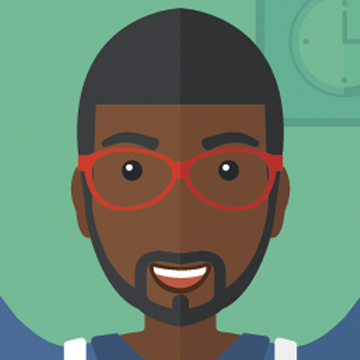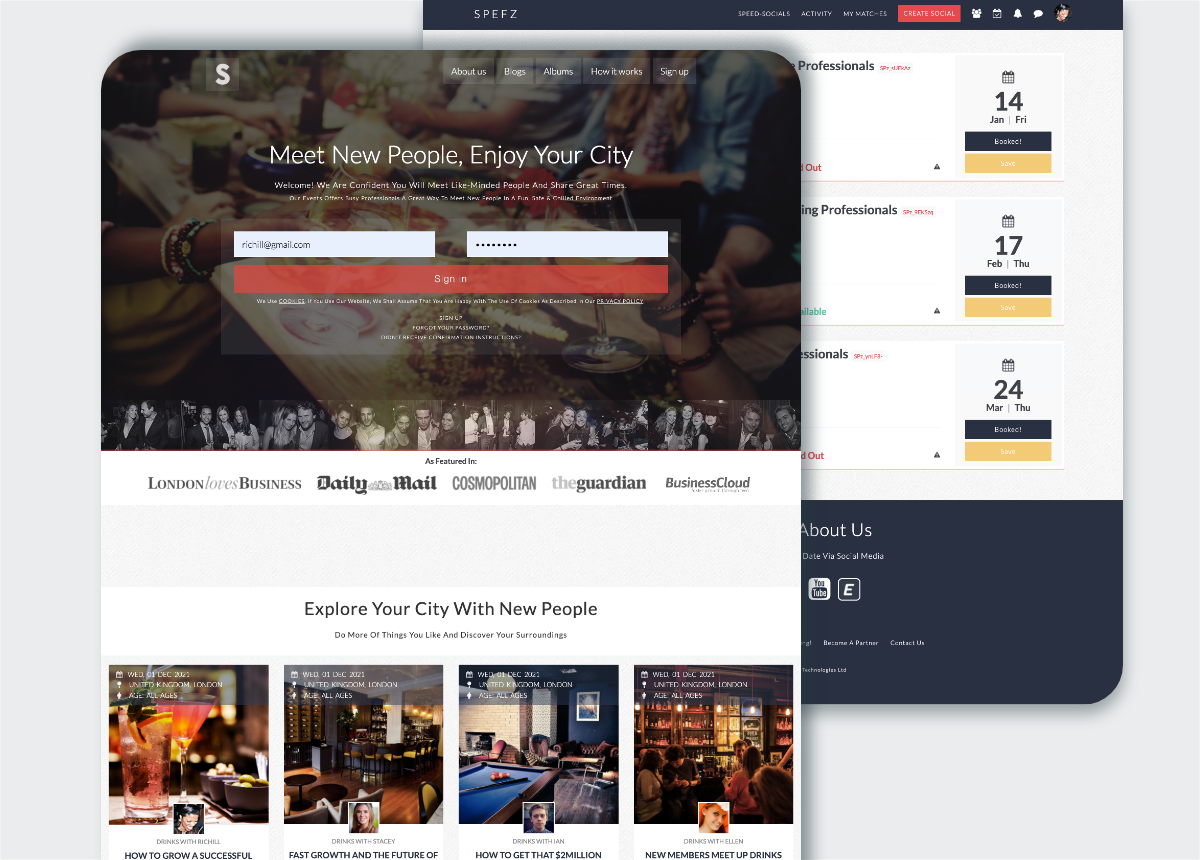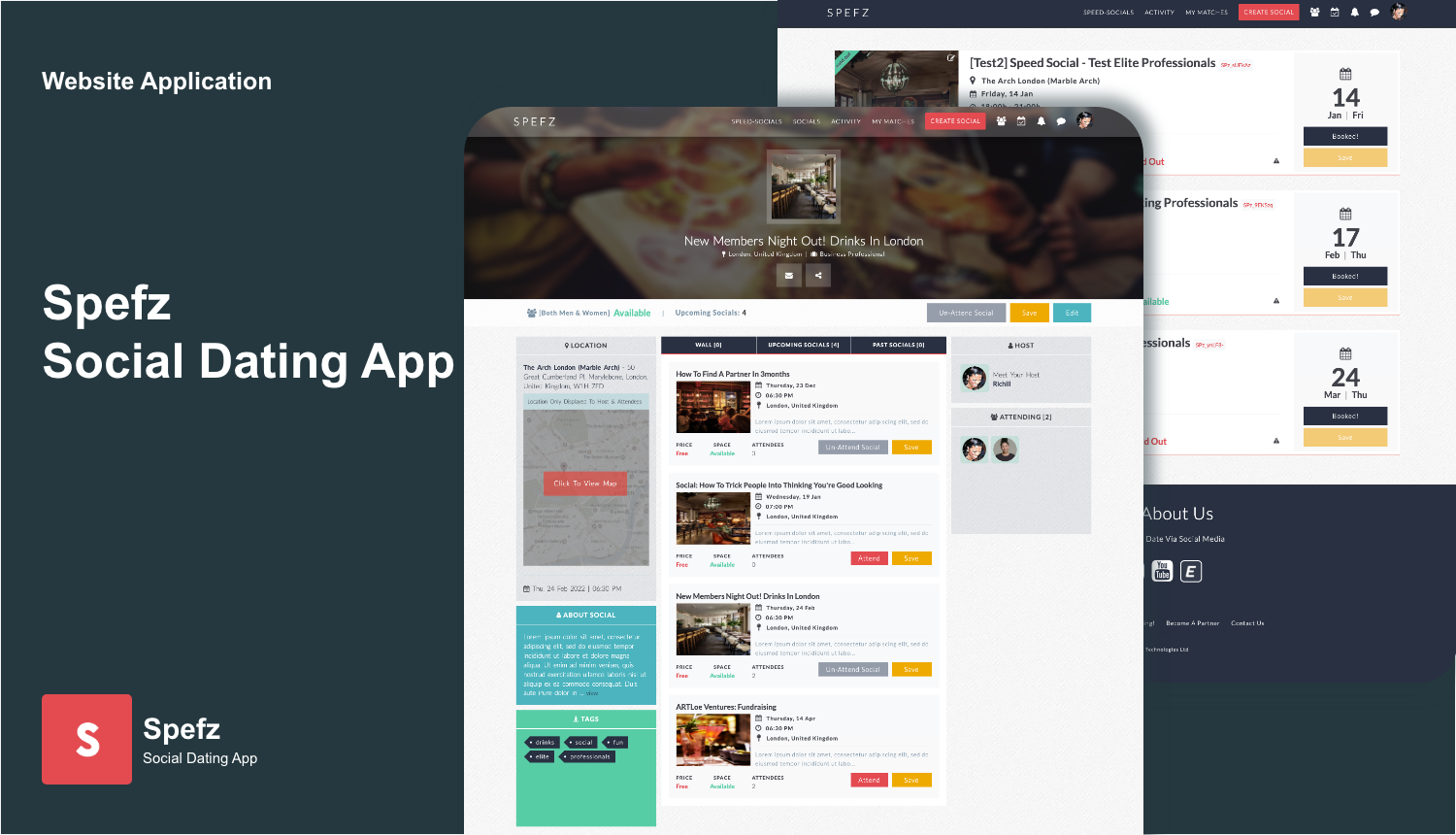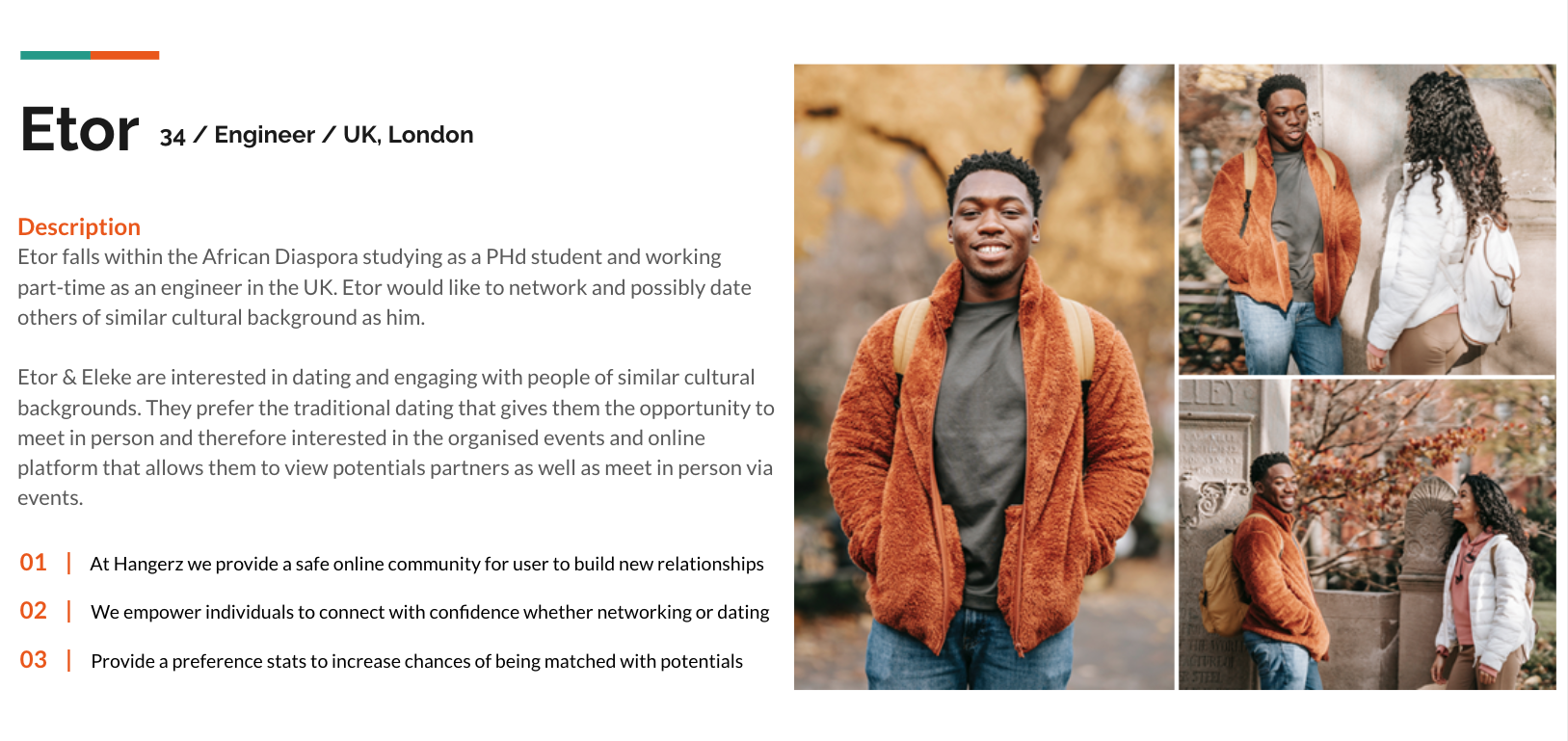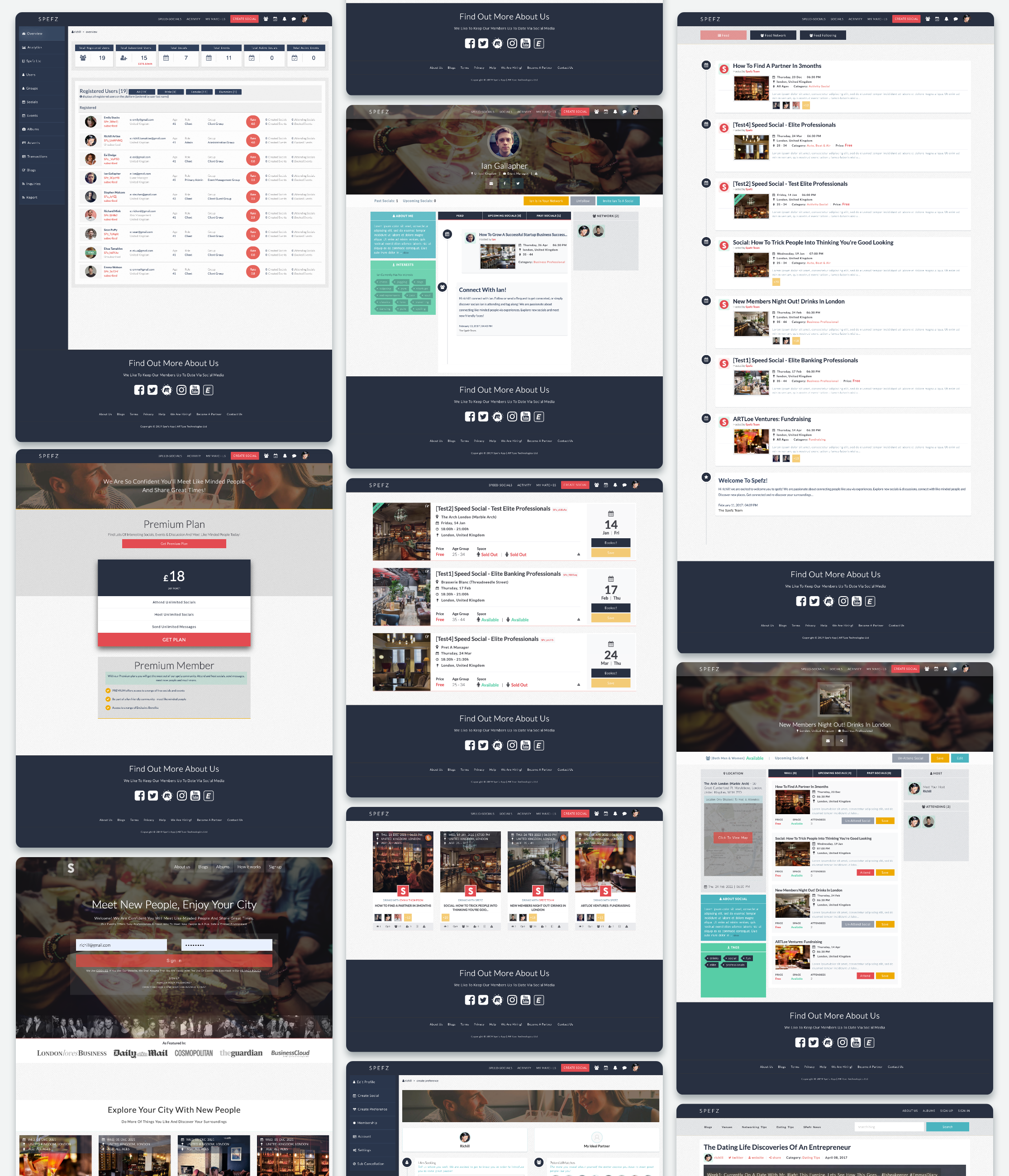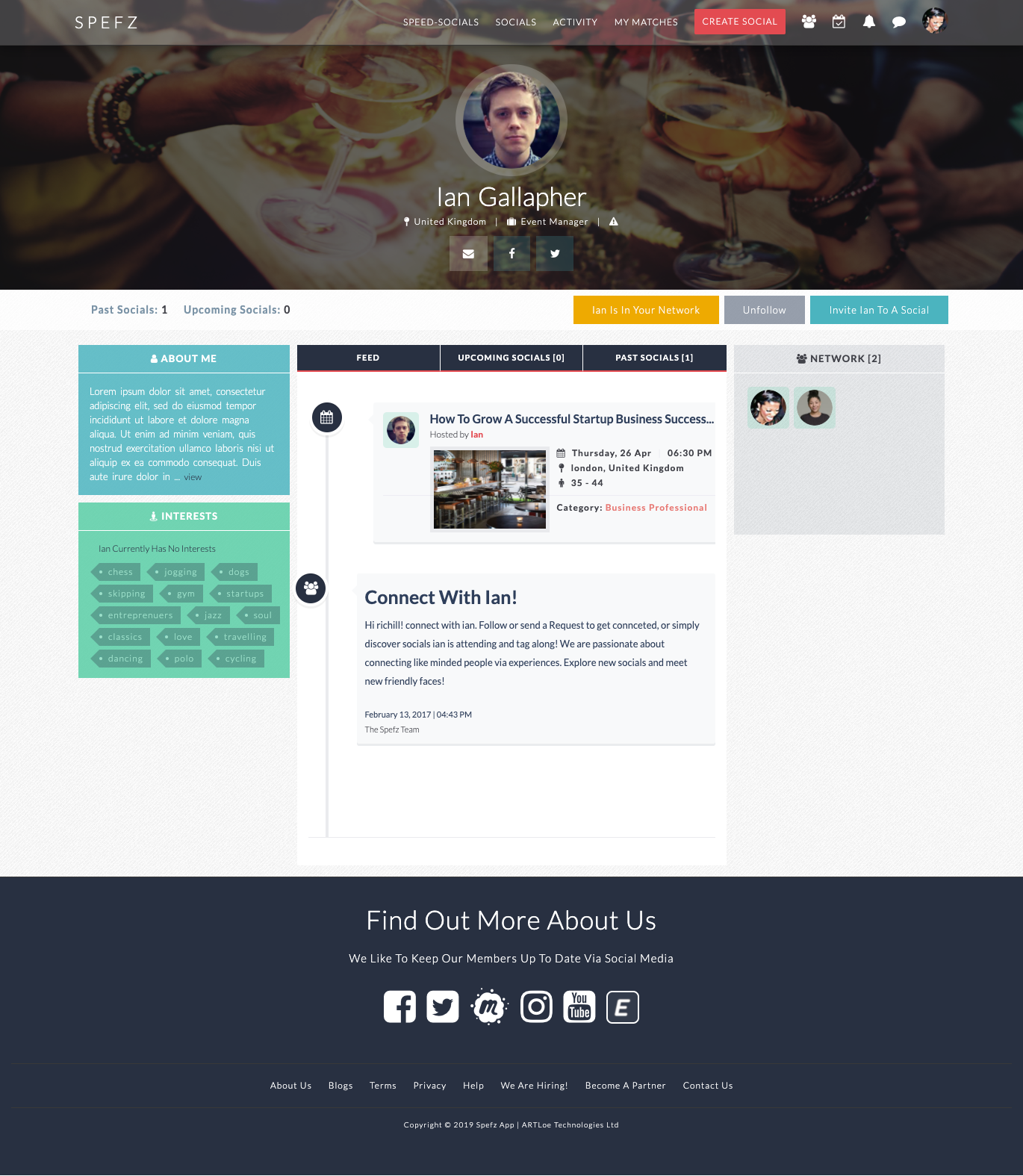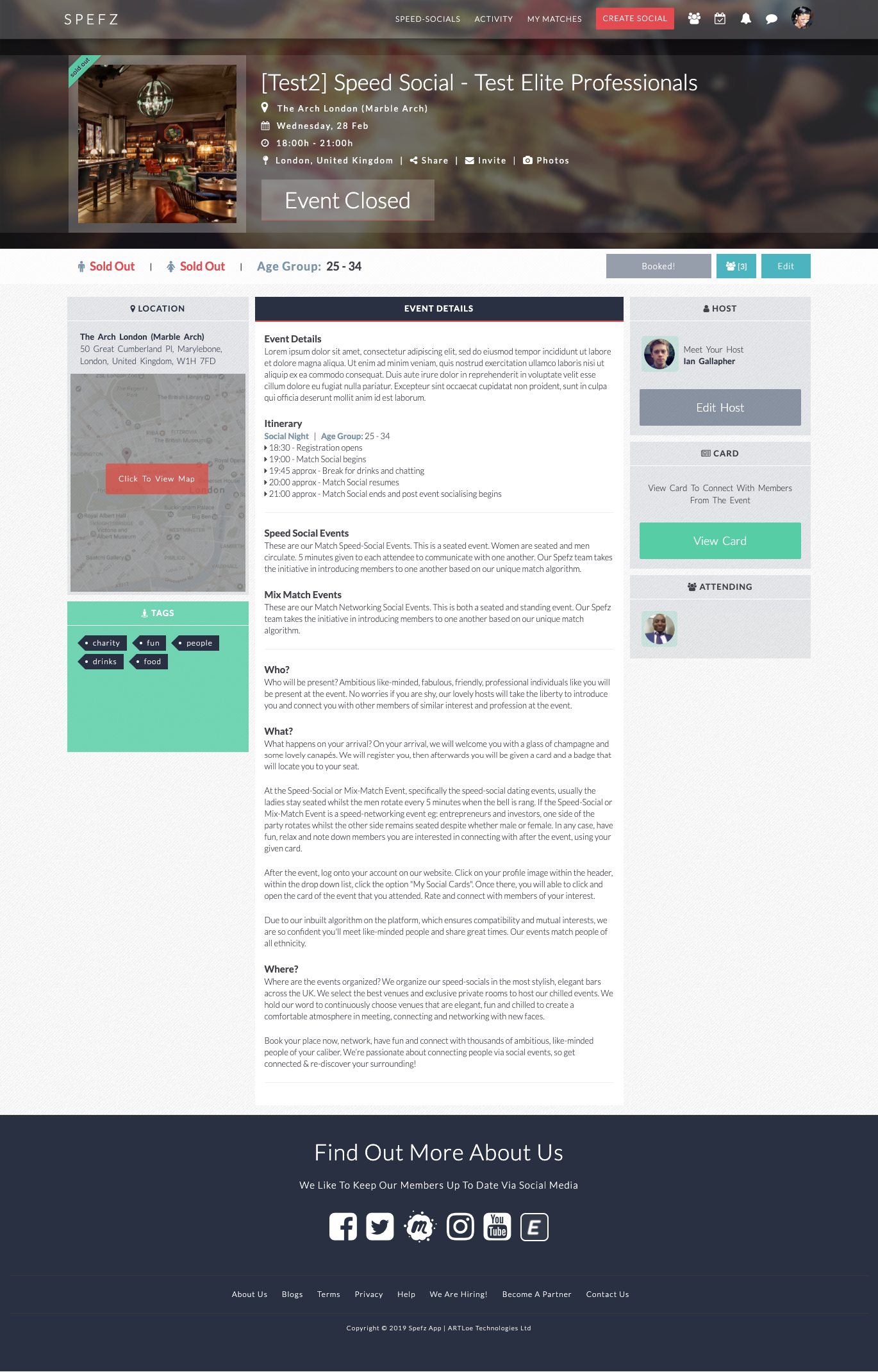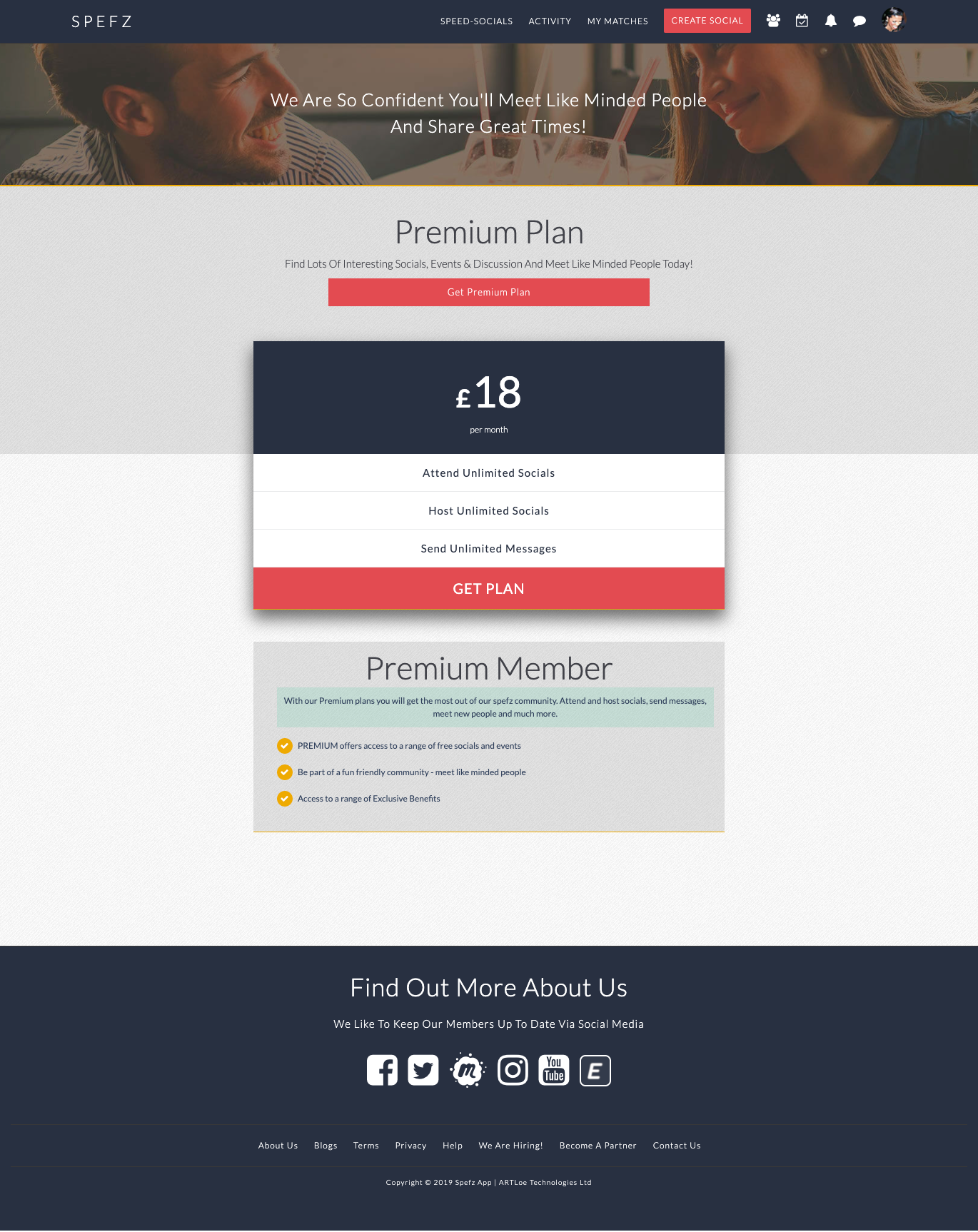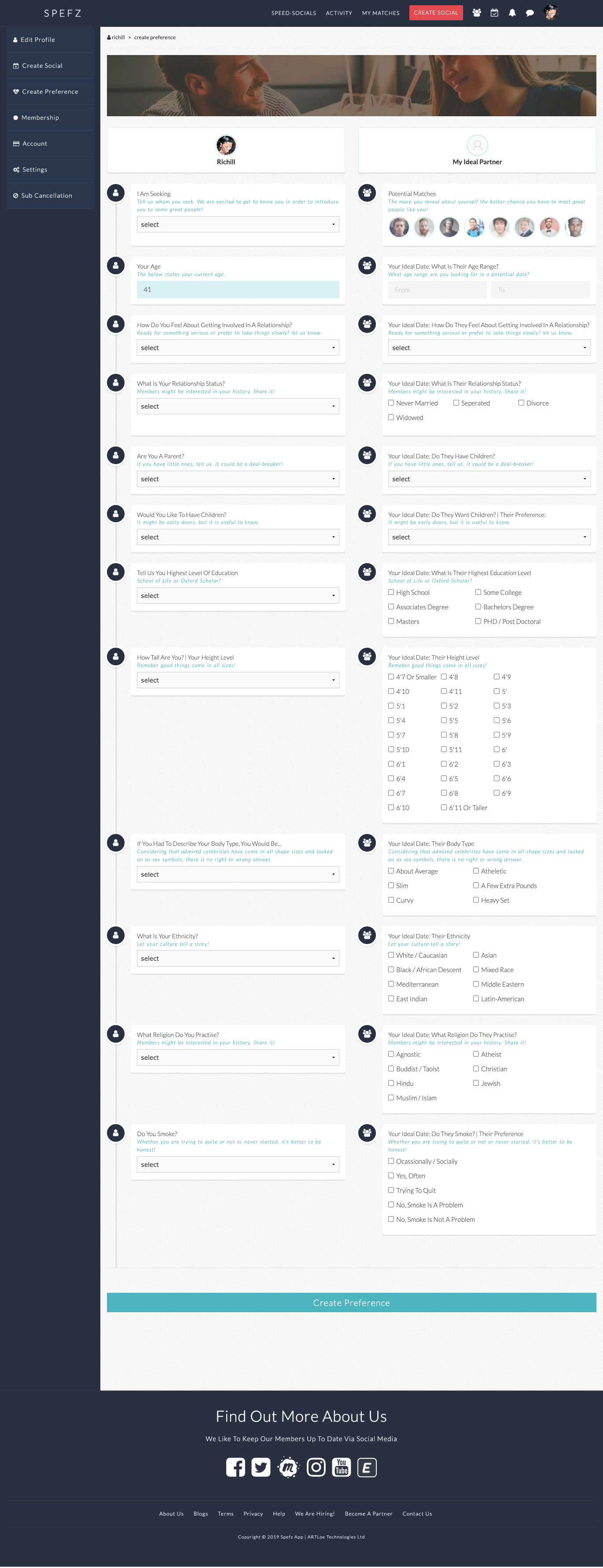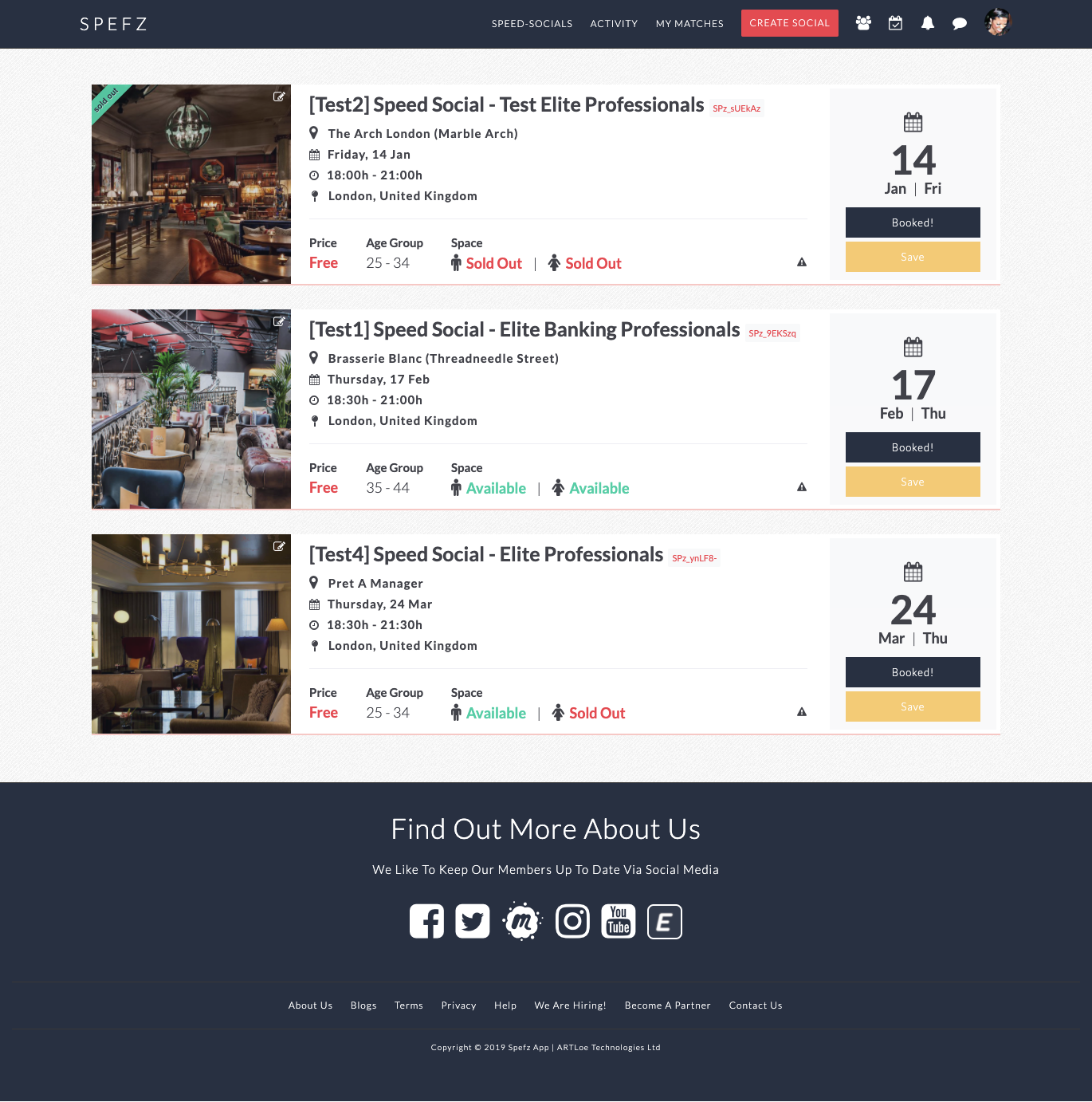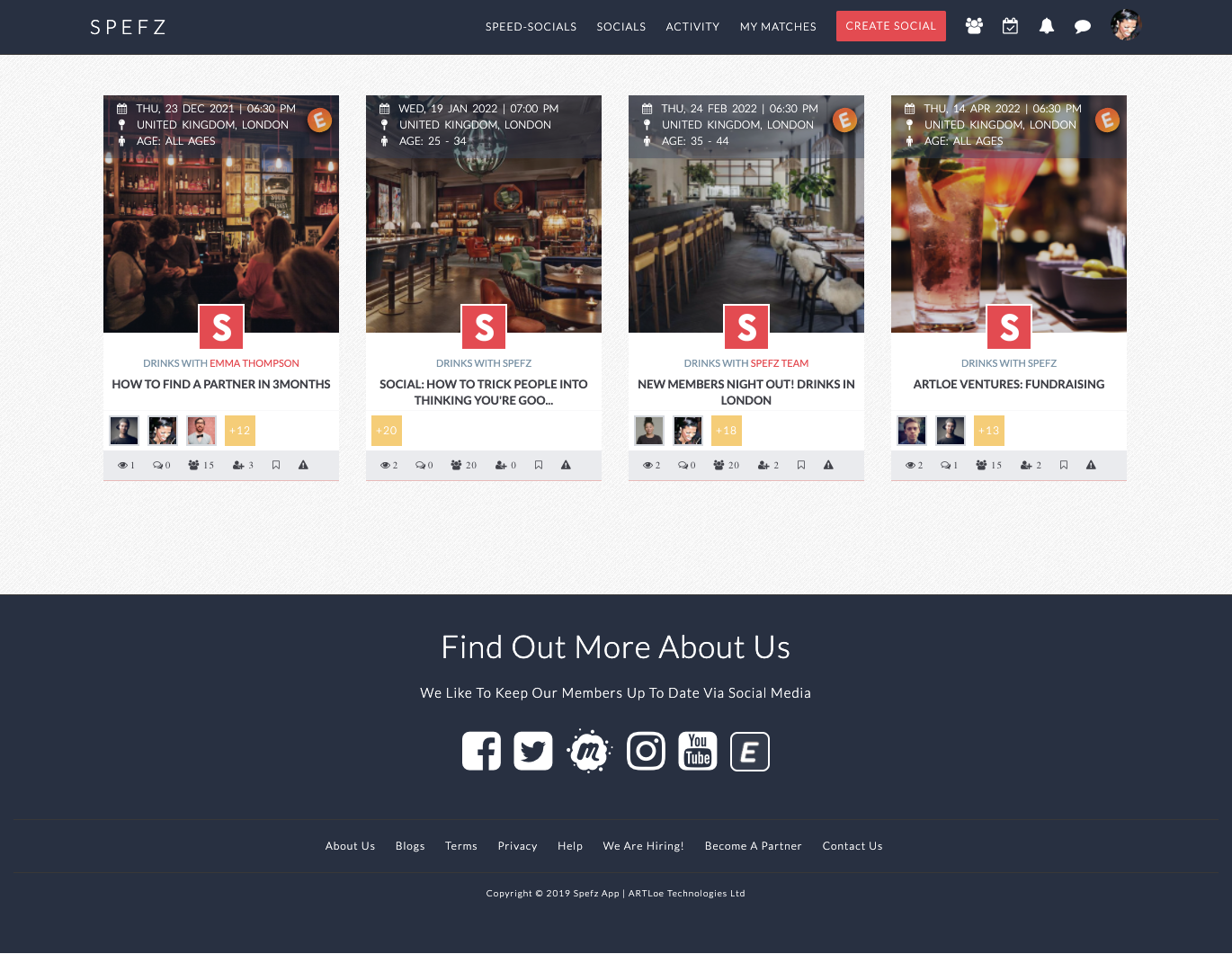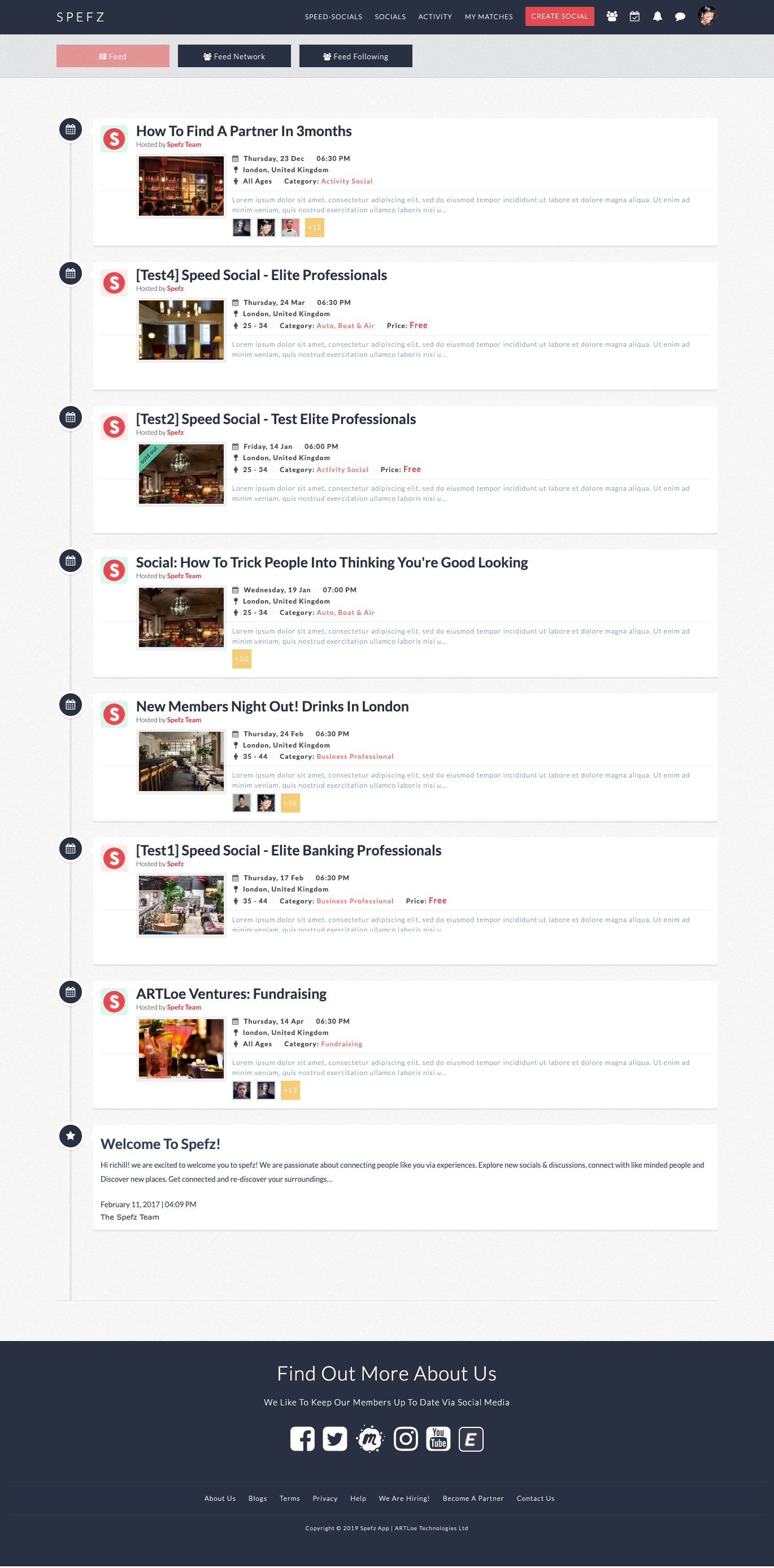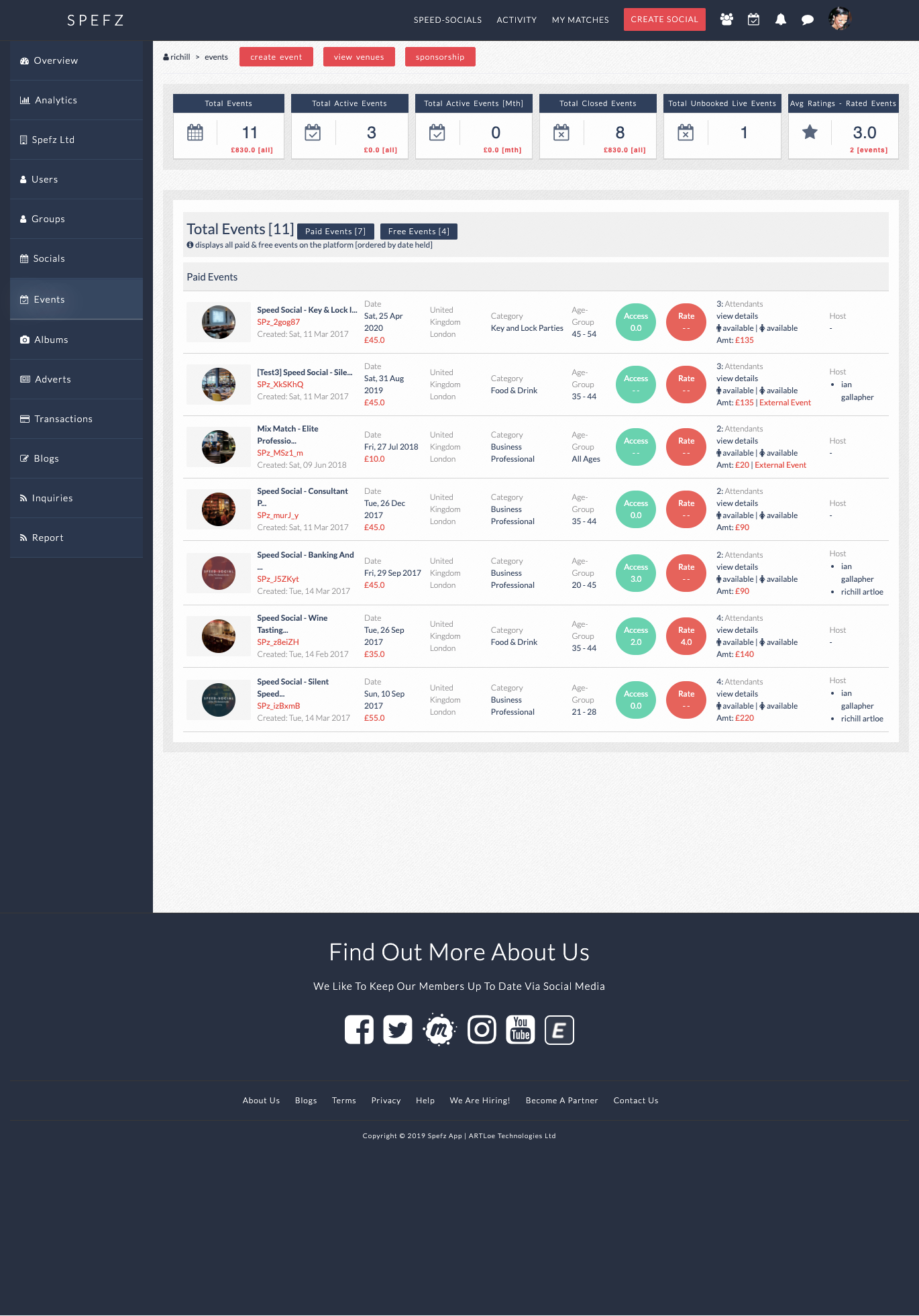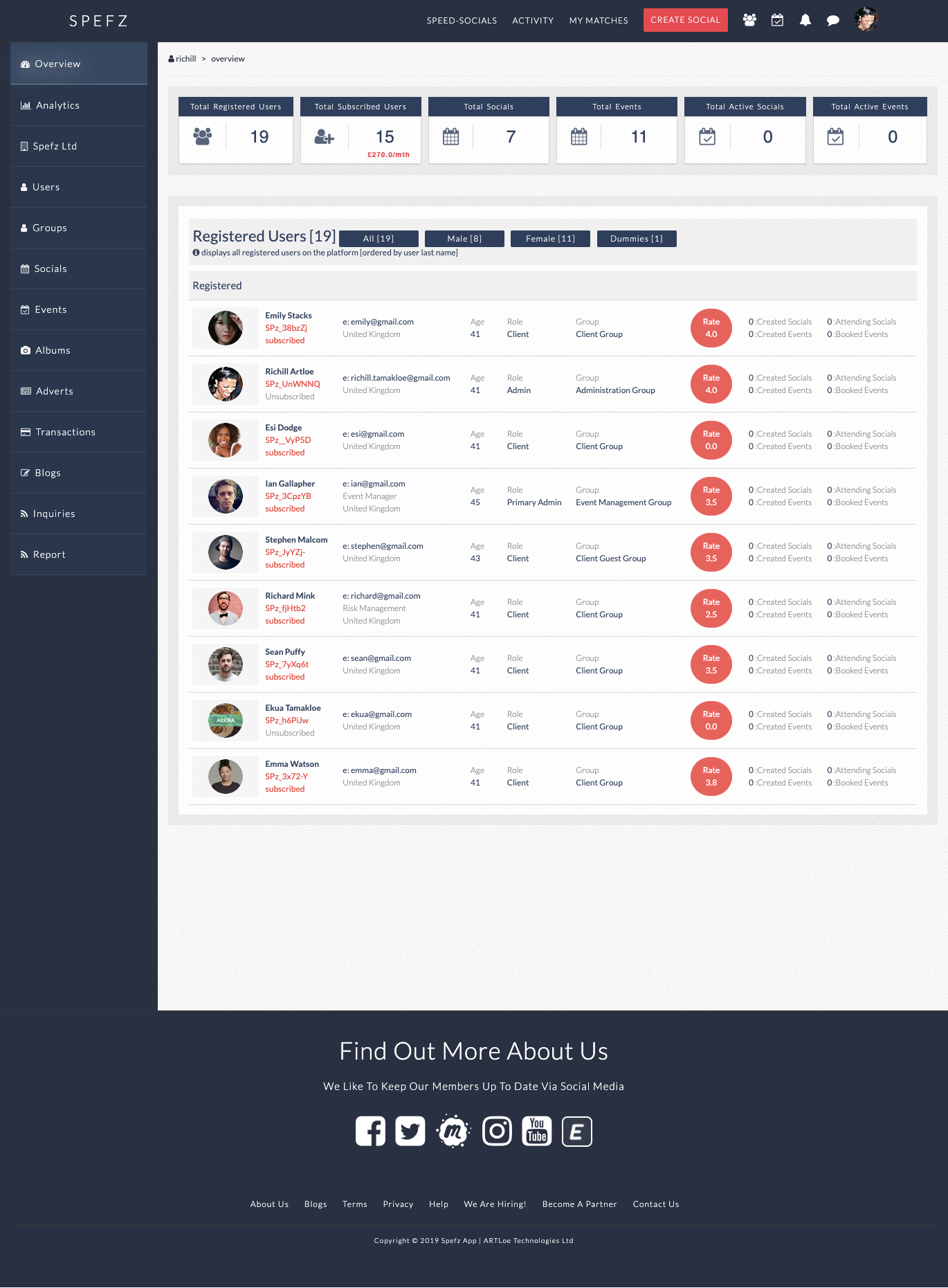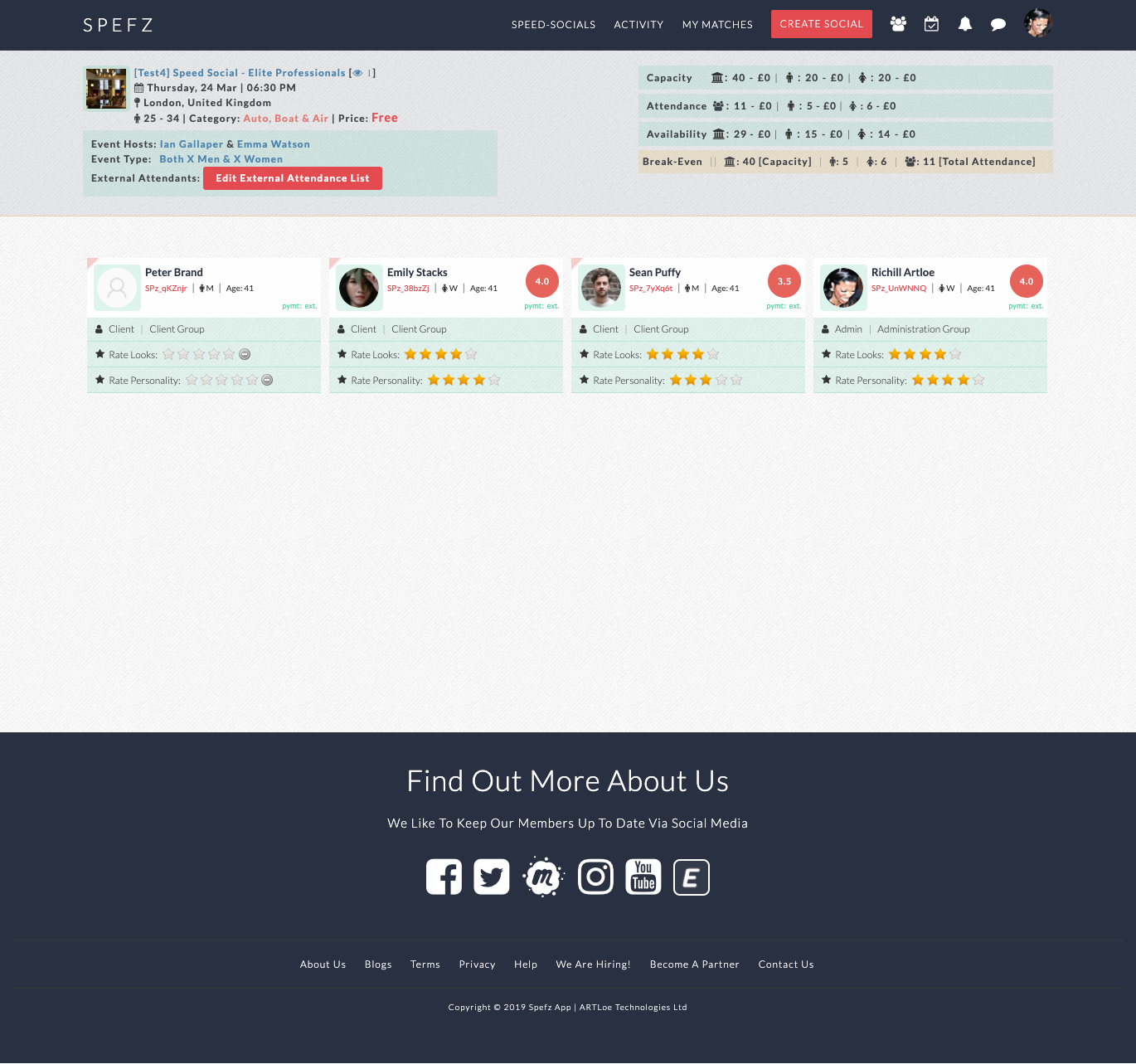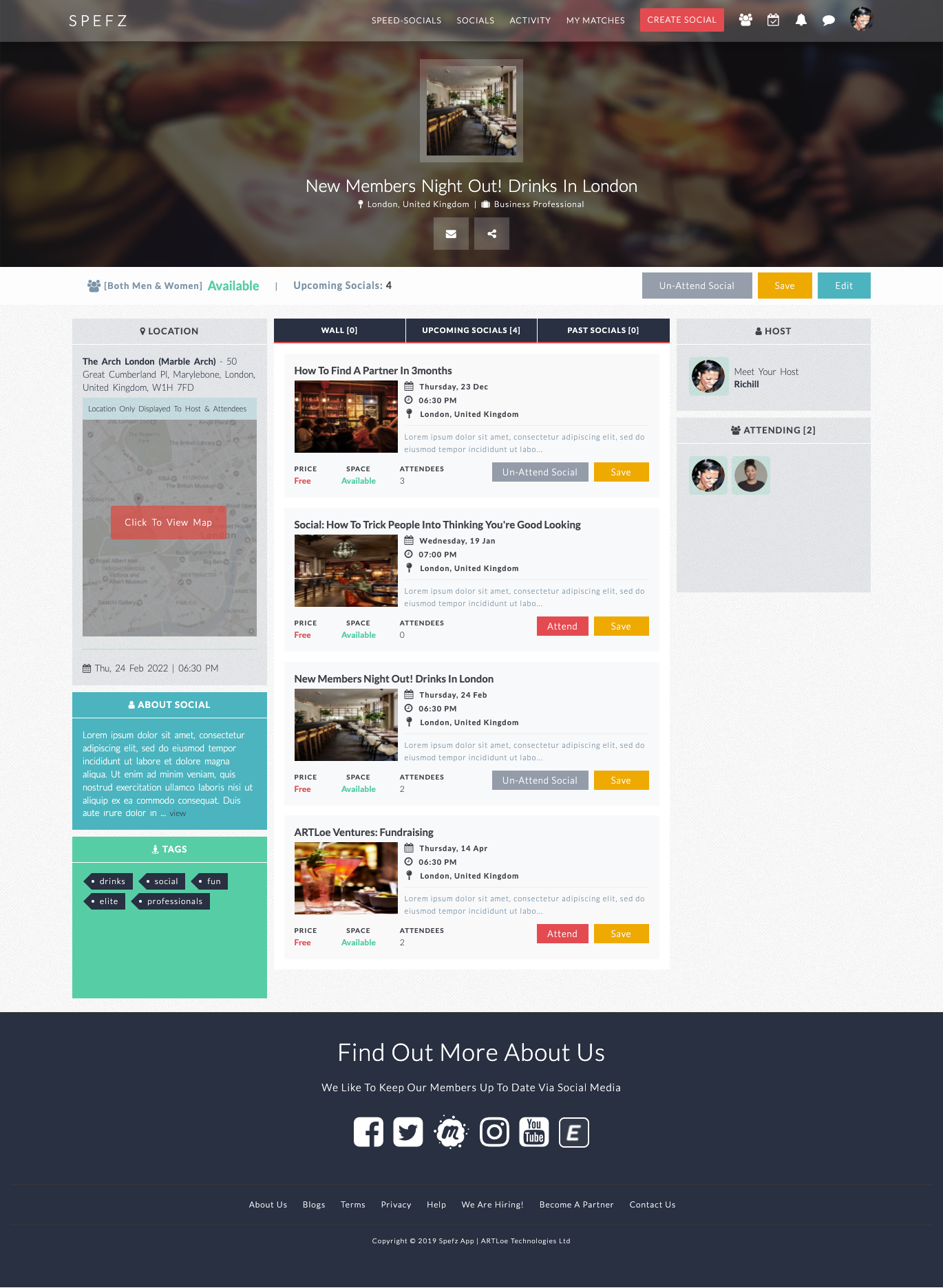|
client
|
Spefz at Spefz |
| sector | Social , Dating , Networking , |
| project time | 3 months |
| my role | Entire product design from research to conception, visualisation and testing |
| my contribution |
|
| services |
|
| team |
Richill ARTLoe(UX/UI Designer)
|
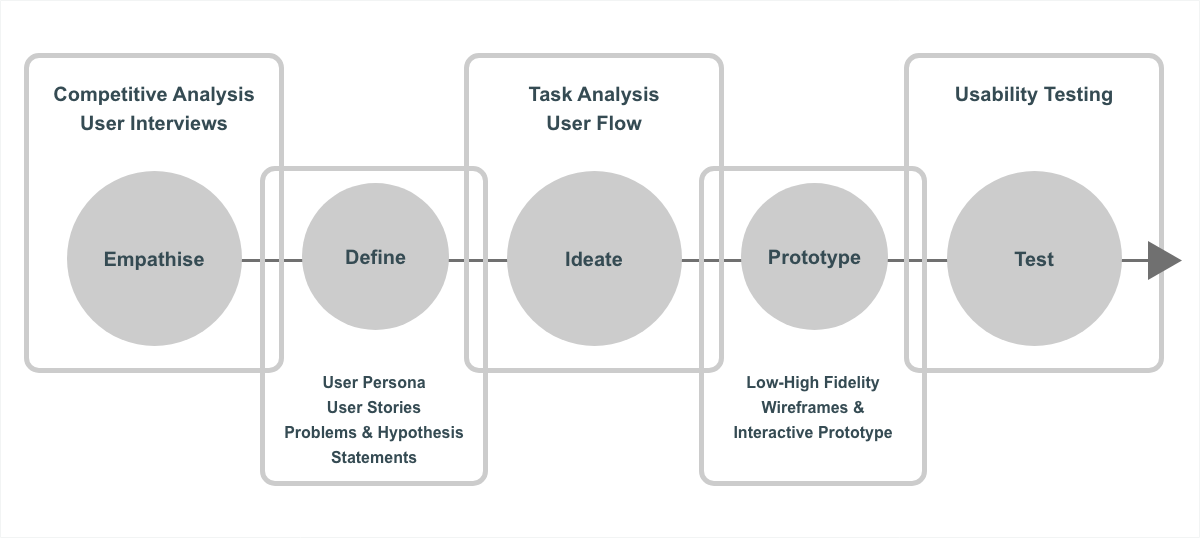
-
problem statement #1
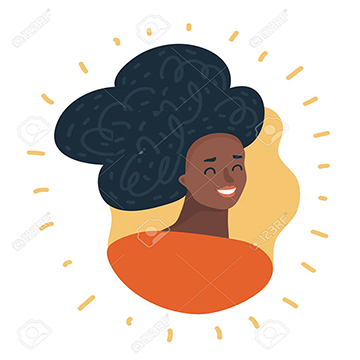 User's Experience - Problem Statement
User's Experience - Problem Statement
Emeka just recently moved to London. He loves meeting new people and since he is new to the city he feels that this a good opportunity for him to create new relationships. Emeka needs a way to meet and engage with new people of his age and preference in a fun safe environment. He is interested in meeeting and creating a connection in person. He is also interested in a serious relationship but feels that websites and apps like SeepdDater.co.uk, E-Harmony, Tindr, Plenty of Fish etc focus mainly on meeting online and can at times be too un-serious and do not tailor to people of his preference and therefore does not feel noticed as much as he would like to be. This creating the frustration of not having the opportunity to meet people intially in person and also scrolling endlessly through incompatible profiles.
Hypothesis
We believe that by creating a visually oriented and appealing interface, we are able to put together q website that helps users engage with nearby people in person through the discovery of real-life socials and events. A website that allows Emeka to meet people of his preference in person and that provides him with more stat info on potential matches.
-
problem #1lack of analysed offline match compatibility (Lack of dating success)
Most dating apps are focused more on online dating rather than offline dating. There are majority of users who still prefer the traditional dating process and would like to match successfully via that process. Most dating apps do not analyse matches based on interest, preferences, personality and appearance. Random members are invited to the dating events, giving registered users an unpleasant and tiring experience of getting a successful match. This lack of analysed compatibility becomes tiresome and creates an unpleasant user experience and eventually results is an increase in members unsubscribing.
-
solution #1increase user engagement by creating a clear and frictionless journey
Increase subscription through maintaining the interest of members via an engaging analysed off-line match process that increases the probability of a successful match. The aim is to create a clear and frictionless journey, and in doing so we can expect to improve brand perception while maintaining and supporting an increase in conversion.
-
sstrength
- several independent ways to generate revenue. Spefz is designed to be affordable and easy to use for the average user. Such user-friendliness will attract many users and make the app very popular.
- niche target audience
- Increased engagement ie: increased conversion due to analysed matches
- Higher success in auto-matches due to analysed matches.
-
wweakness
- vulnerability of user information
- the lack of information on users, about themselves raises the problem of not being able to find the perfect matches.
- difficult to enter the market
- privacy concerns
-
oopportunities
- Can diversify business by foraying into the matrimony market - where there is a huge market prospect in that space.
- ability to improve matching algorithm using new tech eg: face recognition
- Ability to create a niche dating experience
- premium plans can expand popular features
-
tthreats
- The fast progress and advancement of technology may raise the threat of the appearance of new rivals and may put HangezApp application and services at a disadvantageous position
- Financially strong competitors replicating algorithm process
- The company may confront the problem of legislative changes which may interfere into its operations, such as the ban of tracking users’ information
- Strong competitors that offers similar products
-
challenge #0How To Improve The Subscription Experience For Subscribers
Identifying the possible user struggles in-order to highlight insights that will improve user experience to subscribe. Using hotjar on the invisionApp demo provided a general understanding on areas of visitor struggle, current UX issues and some knowledge on technical issues which all ultimately contributed to visitors leaving the app.
-
challenge #0Creating An Engaging Matching Experience For Members
Displaying pop-up guidance and informational stats on members that are likely to be matched, giving the user a more informed experience in having a successful match. In this way, the experience in finding a successful match, a member met at the event, on the app becomes more engaging, pleasant and less tiring.
-
challenge #0How To Improve Members Trust
Displaying a verification tick, to provide users with confidence that majority of members are verified members with authentic accounts and creating a frictionless journey to allow users to be verified on the app. This being a significant key driver to enable members to provide honest information.
-
challenge #0Lack Of Analysed Compatible Matches
The lack of an analysed matching system. Most networking/dating events do not analyse matches based on interest, preferences, personality & appearance, therefore, random members attend the events, giving the registered users an unpleasant & tiring experience in finding a successful match at the event.
-
challenge #0The Lack Of A Niche Site For The Ethnic Community
For many within a specific ethnic community, the experience on mass-marketing dating events like Speeddater.co.uk has been unfulfilling. Usually ethnic millennials are misjudged & typically have to make 10 times more effort than their counterparts to receive an ineterest of response from a potential at the event.
-
challenge #0The Lack Of Offline Potential Matches
Though online dating has it's convenience, there is still a large percentage of individuals that prefer to engage and meet potential partners in person in a fun, safe and chilled environment. There are currently no platforms with an inbuilt matching system for offline socials that ensures compatibility & mutual interests prevails.
-
interview questions #1Interview Questions
1. What is your age?
2. What do you do for a living?
3. What social dating apps do you find most effective in meeting new people?
4. Generally, how do you find the experience of using the social apps of your choice?
5. How could these experience be improved?
-
survey questions #1Survey Questions
1. What is your gender?
2. What is your marital status?
3. What is your age range?
4. What social dating apps do you use more often?
5. What are you interested in when using these social dating apps?
-
key findings #0Attracting The Wrong Type Of Connections Offline
Users expressed that, at times they felt that offline dating could be rather shallow. They expressed, they did not have much success on attending dating events, as majority of the time, most matches were based on looks and therefore, many connections were not genuine due to lack of analysed matched present at the event. This was found to be frustrating.
-
key findings #0Lack Of Compatible Matches
Users feel majority of times, on matching apps, a mass number of un-analysed members are displayed on their screens. Many offline match-wesites do not focused on matching members based on interest & preferences, therefore, random members that are not compatable attend the dating events, giving the user an unpleasant & tiring experience of finding a connecting successful with the right person.
-
key findings #0Members Do Not Feel Noticed Enough
For many within the ethnic community, the experience on mass-marketing dating events like SpeddDater.co.uk has been unfulfilling as members do not feel noticed enough by others of their preference & therefore not given the opportunity to present themselves as who they are.
-
 "I Want To Feel More Noticed By People Of My Preference"Ellaage: 35job: Marketing Consultanteducation: MA In Marketingstatus: SingleElla is a high-end working professional. She grew up in Scotland and just recently moved to London. She loves meeting new people and since she is new to the city and area she feels that this is a good opportunity for her to create new relationships. Ella is single and also interested in a serious relationship but feels that dating events like Speeddater.co.uk are too un-serious and do not tailor to people of her preference and therefore does not feel noticed as much as she would like to be.goalsTo create friendships and potential relationshipsPotential datesMeeting attractive and interesting guystasksLooking for guys of her preferenceFinding attractive matchesFinding matches within her radiusFrustrationsNot meeting people of her cultural preferenceGuys sending in appropriate messagesOften matched wrongly with others out of her preferencehow Spefz helpsSpefz can help in case you have specific preferenceConvenience in meeting people nearbyOffers traditional dating if online dating has not been successful
"I Want To Feel More Noticed By People Of My Preference"Ellaage: 35job: Marketing Consultanteducation: MA In Marketingstatus: SingleElla is a high-end working professional. She grew up in Scotland and just recently moved to London. She loves meeting new people and since she is new to the city and area she feels that this is a good opportunity for her to create new relationships. Ella is single and also interested in a serious relationship but feels that dating events like Speeddater.co.uk are too un-serious and do not tailor to people of her preference and therefore does not feel noticed as much as she would like to be.goalsTo create friendships and potential relationshipsPotential datesMeeting attractive and interesting guystasksLooking for guys of her preferenceFinding attractive matchesFinding matches within her radiusFrustrationsNot meeting people of her cultural preferenceGuys sending in appropriate messagesOften matched wrongly with others out of her preferencehow Spefz helpsSpefz can help in case you have specific preferenceConvenience in meeting people nearbyOffers traditional dating if online dating has not been successful -
 "I Want To Consistently View 'Quality' Potential Matches Within My Preference"Melonyage: 43job: Self-Employededucation: MA In Economicsstatus: Single, 1 ChildMelony is a single mother running her own online e-commerce business. She loves tech development in sales. She also loves meeting with friends for an evening drink. Melony is single and currently looking for a serious relationship. She doesn't have time to be scrolling through endless profiles and would like to be able to view potential matches quite quickly. She also prefers traditional dating, so being able to view events with potential matches of her preference is quite important.goalsTo meet potential dates within preferenceView potential profiles quite quicklyHaving a stats snapshot of matches likely to connecttasksMeeting interesting fun people nearbyScroll through profiles of his preferenceViewing organised socials/events with potential matchesFrustrationsScrolling endlessly through incompatible profilesNot finding potential matches within her radiusNot meeting matches comfortable with her current status as a single motherhow Spefz helpsOffers traditional dating [offline dating]Provides analysed potential matchesDisplays potential matches comfortable with Nana's status
"I Want To Consistently View 'Quality' Potential Matches Within My Preference"Melonyage: 43job: Self-Employededucation: MA In Economicsstatus: Single, 1 ChildMelony is a single mother running her own online e-commerce business. She loves tech development in sales. She also loves meeting with friends for an evening drink. Melony is single and currently looking for a serious relationship. She doesn't have time to be scrolling through endless profiles and would like to be able to view potential matches quite quickly. She also prefers traditional dating, so being able to view events with potential matches of her preference is quite important.goalsTo meet potential dates within preferenceView potential profiles quite quicklyHaving a stats snapshot of matches likely to connecttasksMeeting interesting fun people nearbyScroll through profiles of his preferenceViewing organised socials/events with potential matchesFrustrationsScrolling endlessly through incompatible profilesNot finding potential matches within her radiusNot meeting matches comfortable with her current status as a single motherhow Spefz helpsOffers traditional dating [offline dating]Provides analysed potential matchesDisplays potential matches comfortable with Nana's status -
 "I Want To Be More Informed Analytically Of Potential Matches"Emekaage: 28job: Q&A Testereducation: BA in Managementstatus: singleEmeka loves meeting new people and since he is new to the city he feels that this a good opportunity for him to create new relationships. Emeka needs a way to meet and engage with new people of his age and preference in a fun safe environment. He is interested in meeting and creating a connection in person.goalsTo meet potential dates within preferenceView potential profiles quite quicklyHaving a stats snapshot of matches likely to connecttasksMeeting interesting fun people nearbyScroll through profiles of his preferenceViewing organised socials/events with potential matchesFrustrationsNot meeting people looking to have fun & hangoutPressure in being in a relationship by potential matchesNot able to see potential matches nearbyhow Spefz helpsProvides visual map to view potential matches nearbyConvenience in meeting people within preferenceProvision of match stats to view likely match potentials
"I Want To Be More Informed Analytically Of Potential Matches"Emekaage: 28job: Q&A Testereducation: BA in Managementstatus: singleEmeka loves meeting new people and since he is new to the city he feels that this a good opportunity for him to create new relationships. Emeka needs a way to meet and engage with new people of his age and preference in a fun safe environment. He is interested in meeting and creating a connection in person.goalsTo meet potential dates within preferenceView potential profiles quite quicklyHaving a stats snapshot of matches likely to connecttasksMeeting interesting fun people nearbyScroll through profiles of his preferenceViewing organised socials/events with potential matchesFrustrationsNot meeting people looking to have fun & hangoutPressure in being in a relationship by potential matchesNot able to see potential matches nearbyhow Spefz helpsProvides visual map to view potential matches nearbyConvenience in meeting people within preferenceProvision of match stats to view likely match potentials
-
insight #0participants: 6age range: 25 - 55performed with: Invision app, desktop
Both quantitative and qualitative research were conducted. The primary goal was to gain insight into the journey of a user when seeking the right match/potential at any potential pain points. This would help us to better identify important feature requirements of potential registered users.
Analysis - Findings From Interviews & Survey:
collected data from users interviews was analysed and synthesised into key finding. This was achieved through the use of Affinity Mapping. User survey stats were also explored through graphical representation.With a clickable prototype, the next step was to perform usability tests. Due to COVID and lock down restrictions these were remote moderated tests. Users were assigned situational task and their behaviour was observed. Errors were assessed.
-
insight #0goal:
The goal of the test was to identify learnability of the application for new user on mobile and desktop.
The test will aim to highlight any usability issues and define the usefulness of the application, whiles observing the user completing basic tasks and functions.
task:1. create an account
2. complete preference
3. search for a match
4. subscribe to be a member
5. add a payment method
-
insight #0results:
Affinity mapping (which is a business tool used to organise ideas and data) was utilised to help track and group observations. This was paired with a spreadsheet to document frequency and severity of error along with common usability issues.
observations:1. Most users instinctively skipped onboarding
2. More colour needed to be added to the app
3. App forms [user preference] needed to look more friendly and welcoming
4. Matching process needed to be more intuitive
5. Users wanted to see more stats info on potential matches
The focus of the startup business was to develop a web app that had a great user journey/experience flow in order to initiate an increase in its subscription sales and members registration. We played an essential part in creating the UX/UI Design to enable the startup to achieve it's business goals. This was achieved by improving the below user experience and customer satisfaction features, that were to ultimately help increase more users engage on the web app:
1. quick registration process
2. friendly engaging dating preference form
3. smooth on-boarding experience
4. smooth user subscription journey flow
5. simplistic informative stats on potential user matches & events
6. smooth user experience for administration management
-
challenge #0More Substantive Visual Design
In the meantime, in as much as no visual language has yet been defined, I would define brand attributes in advance, which can be used to orient oneself with regard to the visual appearance as well as (linguistic) formulations.
-
challenge #0If There Was More Time & Budget Available…
Development of further user personas and Journey Maps would have been created. Additional research service could have been provided for the client as the business idea is quite complex and extensive (for example, technical and social challenges).
-
challenge #0Reduced Time & Costs Within Budget
Though the specifications on paper were not clear, the Client was able to communicate with clarity on how the front-end prototype had to be designed, which all fell within the set budget. With all set, we were able to create a prototype that improved the quality of the requirements provided and were able to prevent any potential unnecessary costly future.

